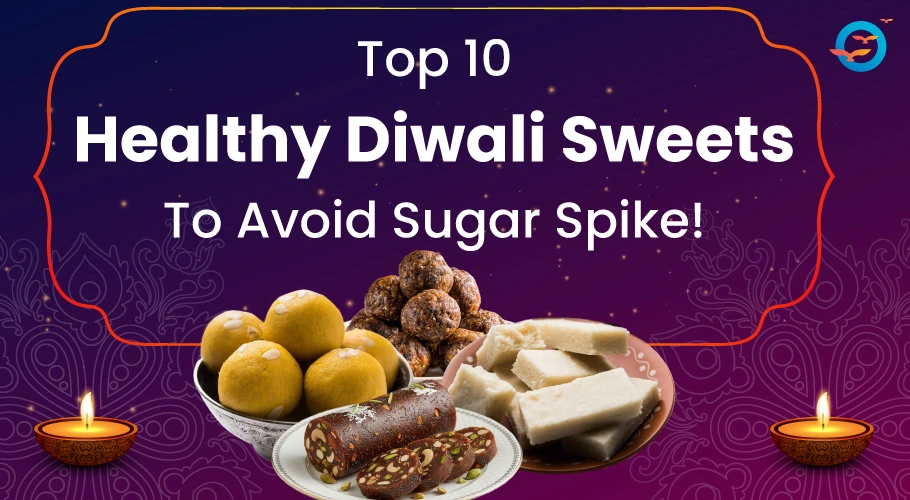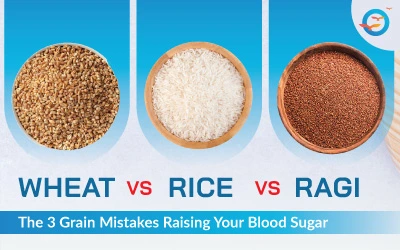Top 10 Healthy Diwali Sweets To Avoid Sugar Spike!

Diwali the festival of lights is also the festival of sweets! But for those managing diabetes or watching their sugar intake, this season often feels like a test of willpower. The good news? You can still enjoy the festival with smart swaps and healthy Diwali sweets that balance taste and health beautifully.
Let’s decode which sweets are safe, moderate, or risky based on their glycemic index (GI), ingredients, and sugar load and how to enjoy them guilt-free.
1. Date Laddoos (Khajur Laddu). The Safest Sweet
Among all Diwali healthy sweets, date laddoos are a clear winner. They’re made with natural sweetness from dates, nuts, and seeds, no refined sugar!
These dates laddu diabetes-friendly options are rich in fiber, magnesium, and healthy fats that slow glucose absorption.
FFD Tip: Add sesame, flax, or almonds for crunch and extra nutrition.
2. Dry Fruit Nut Rolls; High in Nutrients, Low in Sugar
A festive favourite that doubles as a superfood snack! Nut rolls are packed with almonds, pistachios, walnuts, and minimal natural sweeteners.
They’re part of the healthy Diwali faral category because they’re nutrient-dense and provide satiety, reducing sugar cravings.
FFD Tip: Always choose homemade or unsweetened versions.
3. Besan Laddoo; Moderate but Manageable
Made from gram flour (besan), ghee, and jaggery, this sweet has protein and good fats but it’s calorie-dense.
Among healthy Diwali sweets recipes, besan laddoo can fit in small portions for those with good sugar control.
FFD Tip: Replace sugar with stevia or dates, and roast in minimal ghee.
4. Coconut Barfi; A Better Option When Made Smartly
Coconut’s natural fat and fiber make barfi more filling and slower to digest compared to sugar-heavy sweets.
Go for low GI Diwali sweets made with desiccated coconut, stevia, or jaggery instead of sugar syrup.
5. Soan Papdi – Flaky but Not Free (Moderate Sugar / Moderate Health)
Often considered the “light” Diwali sweet, soan papdi contains less ghee and sugar than gulab jamun or jalebi, but still about 18–22 grams of sugar per 100 grams. It’s slightly better because it’s not soaked in syrup but moderation remains key.
6. Rasgulla – Soft but Sugary (High Sugar / Moderate Health)
Rasgulla may seem lighter since it’s not fried, but it still contains about 20–25 grams of sugar per piece. The syrup it’s soaked in adds to the load. If you must indulge, limit yourself to one piece and drain the syrup before eating.
7. Sugar-Free or Jaggery-Based Sweets – The Smart Swap (Very Low Sugar / High Health)
Modern variations like stevia-based barfi, jaggery chikki, or date balls are the best alternatives for those managing diabetes or insulin resistance. These sweets are naturally sweetened and low in refined sugar, helping maintain steady glucose levels while still keeping the festive spirit alive.
8. Rasgulla & Bengali Sweets – High Risk
Rasgulla, chamcham, and sandesh may seem light but are steeped in sugar syrup.
If you’re managing diabetes, these aren’t healthy Diwali sweets; they cause immediate sugar spikes.
FFD Tip: Avoid syrup-based sweets; even “sugar-free” ones can contain artificial sweeteners.
9. Jalebi – Extremely Risky
Deep-fried, soaked in sugar syrup, and low in nutrition, jalebi tops the “avoid” list.
If you must, take just one bite and balance it with a protein-rich meal to prevent sugar surge.
10. Mysore Pak – Tasty but Tricky
Though it’s rich in ghee, Mysore Pak has excessive sugar and calories, making it unsuitable for people with diabetes or high cholesterol.
FFD Tip: Avoid store-bought versions; even small portions can derail sugar control.
Smart Diwali Tips for Sugar Control
Managing sugar control during Diwali doesn’t mean saying no to sweets it’s about making mindful swaps:
- Choose natural sugar substitutes for diabetics like dates or stevia instead of refined sugar.
- Combine sweets with nuts or protein foods to reduce sugar absorption.
- Drink plenty of water and stay active after meals.
Follow Diwali diet tips for diabetics eat your festive foods early in the day, not late at night.
Want to make a sweet that’s safe for diabetes? Discover our Diabetic-Friendly Moong Dal Laddu Recipe now!
FAQs
1. Which Diwali sweets are considered the safest options for blood sugar management?
Date laddoos, dry fruit nut rolls, and sesame laddoos are the safest.
2. Why are Nut Rolls and Date Laddoos considered safe for diabetics?
They’re rich in fiber, protein, and natural sugars that don’t cause rapid sugar spikes.
3. Is Besan Laddoo a good option for people with high blood sugar?
Yes, if made with jaggery or stevia and eaten in moderation.
4. How much sugar does Jalebi contain?
A single piece can have up to 15–20g of sugar high enough to spike blood sugar instantly.
5. What makes Bengali sweets risky for diabetics?
They’re soaked in sugar syrup, causing high glycemic load.
6. How can I control sweet cravings during Diwali?
Add protein, fiber, and good fats to your meals; eat slowly to feel satiated.
7. Which Diwali sweets are moderately risky for diabetics?
Coconut barfi and baked karanji can be enjoyed occasionally in small portions.
8. What are the most dangerous or high-risk Diwali sweets?
Jalebi, rasgulla, and Mysore Pak are best avoided.
9. Why is Mysore Pak not suitable for people with high cholesterol?
It’s rich in ghee and sugar, which raise both blood sugar and cholesterol levels.

